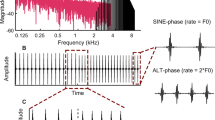Abstract.
The object of the study was to look for a neurophysiological substrate of sequential auditory stream segregation. When a sequence of tones alternates rapidly between pitches separated by more than a few semitones, there is a tendency for it to be perceived as two independent "streams". We examined the scalp potentials evoked when the pitch interval abruptly changes, to see whether there are response parameters which might be correlated with sudden stream segregation and/or integration. For 3 s a continuous synthesized tone of "clarinet" timbre oscillated between pitches of F4 and F#4 (one semitone higher) at 16 notes/s, perceived as an integrated stream. The upper note was then raised to E5 (11 semitones above F4, perceived as segregated streams) for a further 3 s and the cycle was repeated 40 times. In a second condition also starting with oscillation between F4 and F#4, the upper note was lowered to E4 (one semitone below F4, still perceived as a single stream). Further conditions examined the changes between oscillations of 1 and 11 semitones down from E5, 1 and 23 semitones up from F4, and 10 and 11 semitones up from F4. Virtually no potentials were detectable during the periods of unchanging oscillation, but an N1/P2 complex was evoked on each change in the pitch interval. The N1 was termed "MN1" on account of its arguable relatedness to the mismatch negativity, recorded in a separate experiment using discontinuous tones at a much slower rate. The mean peak latency of the MN1 varied between 96 and 123 ms, the shortest latencies being recorded, not to the largest changes of pitch interval but to the widest pitch intervals between the new tone and the immediately preceding one. Therefore, although a causal relationship with streaming cannot necessarily be inferred, the MN1 latency appears to mark the degree of pitch contrast between consecutive tones, in correlation with the streaming effect.
Similar content being viewed by others
Author information
Authors and Affiliations
Additional information
Electronic Publication
Rights and permissions
About this article
Cite this article
Hung, .J., Jones, .S. & Pato, V.M. Scalp potentials to pitch change in rapid tone sequences. Exp Brain Res 140, 56–65 (2001). https://doi.org/10.1007/s002210100783
Received:
Accepted:
Issue Date:
DOI: https://doi.org/10.1007/s002210100783



